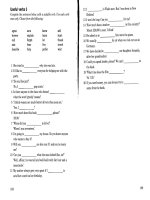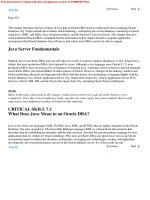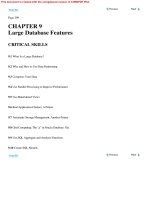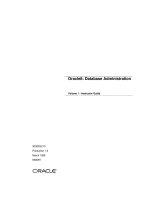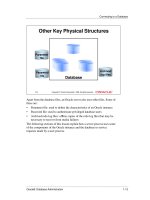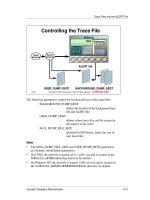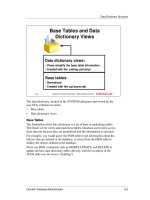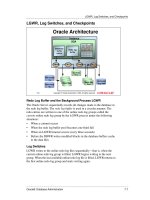oracle 8 database administration volume 1 instruction guide phần 10 doc
Bạn đang xem bản rút gọn của tài liệu. Xem và tải ngay bản đầy đủ của tài liệu tại đây (137.84 KB, 36 trang )
Oracle Data Types
......................................................................................................................................................
Restricted ROWID
• Can identify rows within a segment
• Needs less space
BBBBBBBB
Block number
12-8
.
RRRR
Row number
.
FFFF
File number
Copyright © Oracle Corporation, 1998. All rights reserved.
Earlier versions of Oracle used the restricted ROWID format. A restricted
ROWID used only 6 bytes internally and did not contain the data object
number. This format was acceptable in Oracle7 or an earlier release, because
the file numbers were unique within a data base. Thus earlier releases did
not permit more than 1022 data files.
Even though Oracle8 removed this restriction by using tablespace-relative
file numbers, the restricted ROWID is still used in objects like
nonpartitioned indexes on nonpartitioned tables where all the index entries
refer to rows within the same segment.
......................................................................................................................................................
Oracle8: Database Administration
12-13
Lesson 12: Managing Tables
......................................................................................................................................................
Collections
• Collections are objects that contain
objects.
• VARRAYs are ordered sets of elements
containing a count and a limit.
• Nested tables are tables with a column
or variable of the TABLE data type.
VARRAY
12-9
Nested
table
Copyright © Oracle Corporation, 1998. All rights reserved.
Collections
Two types of collection data types are available to store data that is repetitive
for a given row in a table. The objects option is needed to define and use
collections. A brief discussion of these types follows.
Varying Arrays (VARRAYS)
Varying arrays are useful to store lists that contain a small number of
elements, such as phone numbers for a customer.
VARRAYS have the following characteristics:
• An array is an ordered set of data elements.
• All elements of a given array are of the same data type.
• Each element has an index, which is a number corresponding to the
position of the element in the array.
• The number of elements in an array is the size of the array.
• Oracle allows arrays to be of variable size, which is why they are called
VARRAYs, but the maximum size must be specified when declaring the
array type.
......................................................................................................................................................
12-14
Oracle8: Database Administration
Oracle Data Types
......................................................................................................................................................
Nested Tables
Nested tables provide a means of defining a table as a column within a table.
They can be used to store sets that may have a large number of records such
as number of items in an order. In this example, ORDERS is the parent table,
and ITEMS is the nested table.
Nested tables generally have the following characteristics:
• A nested table is an unordered set of records or rows.
• The rows in a nested table have the same structure.
• Rows in a nested table are stored separate from the parent table with a
pointer from the corresponding row in the parent table.
• Storage characteristics for the nested table can be defined by the
database administrator.
• There is no predetermined maximum size for a nested table.
Relationship Type (REF)
Relationship types are used as pointers within the database. The use of these
types require the Objects option. As an example, each item that is ordered
could point to, or reference a row in the PRODUCTS table, without having
to store the product code.
User-Defined Types
Oracle allows a user to define abstract data types and use them within the
application. The use of this feature requires the Objects option.
......................................................................................................................................................
Oracle8: Database Administration
12-15
Lesson 12: Managing Tables
......................................................................................................................................................
Creating a Table
Creating a Table
CREATE TABLE employees(
empno NUMBER(4),
last_name VARCHAR2(30)
deptno NUMBER(2))
PCTFREE 20 PCTUSED 50
STORAGE(INITIAL 200K NEXT 200K
PCTINCREASE 0 MAXEXTENTS 50)
TABLESPACE data01;
12-10
Copyright © Oracle Corporation, 1998. All rights reserved.
Syntax
Use the following command to create a table:
CREATE TABLE [schema.] table
(column datatype [ , column datatype ] ...)
[TABLESPACE tablespace ]
[ PCTFREE integer ]
[ PCTUSED integer ]
[ INITRANS integer ]
[ MAXTRANS integer ]
[ STORAGE storage-clause ]
[LOGGING | NOLOGGING]
[CACHE | NOCACHE] ]
......................................................................................................................................................
12-16
Oracle8: Database Administration
Creating a Table
......................................................................................................................................................
where:
schema
table
column
data type
TABLESPACE
PCTFREE
PCTUSED
INITRANS
MAXTRANS
STORAGE
LOGGING
NOLOGGING
is the owner of the table
is the name of the table
is the name of the column
is the data type of the column
identifies the tablespace where the table
will be created
is the amount of space reserved in each
block (in a percentage of total space minus
the block header) for rows to grow in length
determines lower limit of space used on a
block (after it fills to PCTFREE) before it
becomes available for further row inserts
specifies the number of transaction entries
preallocated in each block (The default is
1.)
limits the number of transaction entries that
can be allocated to each block (The default
is 255.)
identifies the storage clause that determines
how extents will be allocated to the table
specifies that the creation of the table will
be logged in the redo log file
(It also specifies that all subsequent
operations against the table are logged. This
is the default.)
specifies that the creation of the table and
certain types of data loads will not be
logged in the redo log file
......................................................................................................................................................
Oracle8: Database Administration
12-17
Lesson 12: Managing Tables
......................................................................................................................................................
CACHE
NOCACHE
specifies that the blocks retrieved for this
table are placed at the most recently used
end of the LRU list in the buffer cache even
when a full table scan is performed
specifies that the blocks retrieved for this
table are placed at the least recently used
end of the LRU list in the buffer cache when
a full table scan is performed
Note
• Generally tables must be created with a primary key. The maintenance of
constraints is discussed in the lesson “Maintaining Data Integrity.”
• If MINIMUM EXTENT has been defined for the tablespace, the extent
sizes for the table will get rounded up to the next higher multiple of the
MINIMUM EXTENT value.
• If the [NO]LOGGING clause is omitted, the logging attribute of the
table defaults to the logging attribute of the tablespace in which it
resides.
• If MINEXTENTS is specified to a value greater than one and the
tablespace contains more than one data file, the extents will be spread
across the different files in the tablespace.
OEM
1 Use Oracle Schema Manager.
2 Select Object—>Create.
3 Choose Table from the list of values and click OK.
4 Choose Create Table Manually in the New Table dialog box.
5 Click OK.
6 Enter the General, Storage, and Options information in the property
sheet.
7 Click Create.
Alternatively, select an existing table from the navigator, and use
Object—>Create Like to create a new table with the same column and
storage characteristics as an existing table.
......................................................................................................................................................
12-18
Oracle8: Database Administration
Creating a Table
......................................................................................................................................................
Other Options
1 While using Oracle Schema Manager, the user also has the option to let
the tool automatically define the storage and block utilization parameters
based on an estimate of the initial volume, the growth rate, and the DML
activity on the table.
2 On Windows NT, it is possible to use the Table Creation wizard inside
the Oracle Schema Manager to create a table.
Instructor Note
Demonstrate the use of the Table Wizard or Auto Calculation of storage and
block utilization parameters in Oracle Schema Manager.
......................................................................................................................................................
Oracle8: Database Administration
12-19
Lesson 12: Managing Tables
......................................................................................................................................................
Creating a Table: Guidelines
• Use a few standard extent sizes for
tables to reduce tablespace
fragmentation.
• Use the CACHE clause for frequently
used, small tables.
12-11
ã
ã
ã
ã
Copyright â Oracle Corporation, 1998. All rights reserved.
Place tables in a separate tablespace—not in the tablespace that has
rollback segments, temporary segments, and indexes.
Use a few standard extent sizes that are multiples of
5*DB_BLOCK_SIZE to minimize fragmentation.
To improve performance of full table scans, align extent sizes with
DB_FILE_MULTIBLOCK_READ_COUNT, which is an initialization
parameter that defines how many blocks are requested by the server
processes in each read call to the operating system while reading the
whole table.
Use the CACHE clause for small reference tables that are likely to be
accessed very frequently.
......................................................................................................................................................
12-20
Oracle8: Database Administration
Creating a Table
......................................................................................................................................................
Setting PCTFREE and PCTUSED
• Compute PCTFREE
(Average Row Size − Initial Row Size) * 100
Average Row Size
• Compute PCTUSED
Average Row Size * 100
100 − PCTFREE −
Available Data Space
12-12
Copyright © Oracle Corporation, 1998. All rights reserved.
Setting PCTFREE
A higher PCTFREE affords more room for updates within a database block.
Set a higher value if the table contains:
• Columns that are initially null and later updated with a value
• Columns that are likely to increase in size as a result of an update
A higher PCTFREE will result in lower block density—each block can
accommodate fewer rows.
The formula specified above ensures that there is enough free space in the
block for row growth.
Setting PCTUSED
Set PCTUSED to ensure that the block is only returned to the free list when
there is sufficient space to accommodate an average row. If a block on the
free list does not contain sufficient space for inserting a row, the Oracle
server looks up the next block on the free list. This linear scan continues
until either a block with sufficient space is found or the end of the list is
reached. Using the formula given reduces the time taken to scan the free list
by increasing the probability of finding a block with the required free space.
Note
The value for average row size can be estimated using the ANALYZE
TABLE command, which is discussed in a subsequent section.
......................................................................................................................................................
Oracle8: Database Administration
12-21
Lesson 12: Managing Tables
......................................................................................................................................................
Row Migration and Chaining
After
update
Before
update
12-13
Copyright © Oracle Corporation, 1998. All rights reserved.
Row Migration
If PCTFREE is set to a low value, there may be insufficient space in a block
to accommodate a row that grows as a result of an update. When this
happens, the Oracle server will move the entire row to a new block and leave
a pointer from the original block to the new location. This process is referred
to as row migration. When a row is migrated, I/O performance associated
with this row decreases because the Oracle server must scan two data blocks
to retrieve the row.
Row Chaining
Row chaining occurs when a row is too large to fit into any block. This
might occur when the row contains columns that are very long. In this case,
the Oracle server divides the row into smaller chunks called row pieces.
Each row piece is stored in a block along with the necessary pointers to
retrieve and assemble the entire row. Row chaining can be minimized by
choosing a higher block size or by splitting the table into multiple tables
with fewer number of columns, if possible.
......................................................................................................................................................
12-22
Oracle8: Database Administration
Creating a Table
......................................................................................................................................................
Copying an Existing Table
CREATE TABLE new_emp
STORAGE(INITIAL 200K NEXT 200K
PCTINCREASE 0 MAXEXTENTS 50)
NOLOGGING
TABLESPACE data01
AS
SELECT * FROM scott.employees;
12-14
Copyright © Oracle Corporation, 1998. All rights reserved.
Use the CREATE TABLE command with a subquery to copy an existing
table in full or in part.
The simplified syntax for this command is:
CREATE TABLE [schema.]table
[ LOGGING | NOLOGGING ]
...
AS
subquery
The other clauses such as TABLESPACE, STORAGE, and block utilization
parameters can be specified while creating a table based on another table.
Use the NOLOGGING clause to suppress generation of redo log entries and
speed up the creation of the table.
Constraints, triggers, and table privileges are not copied to the new table that
is created in this manner. If a column was defined as NOT NULL in the
original table, the corresponding column in the new table will also be
defined as NOT NULL.
......................................................................................................................................................
Oracle8: Database Administration
12-23
Lesson 12: Managing Tables
......................................................................................................................................................
Controlling Space Used by Tables
Changing Storage and Block
Utilization Parameters
ALTER TABLE scott.employees
PCTFREE 30
PCTUSED 50
STORAGE(NEXT 500K
MINEXTENTS 2
MAXEXTENTS 100);
12-15
Copyright © Oracle Corporation, 1998. All rights reserved.
Some of the storage parameters and any of the block utilization parameters can
be modified by using the ALTER TABLE command.
Syntax
ALTER TABLE [schema.]table
{[ storage-clause ]
[ PCTFREE integer ]
[ PCTUSED integer ]
[ INITRANS integer ]
[ MAXTRANS integer]}
......................................................................................................................................................
12-24
Oracle8: Database Administration
Controlling Space Used by Tables
......................................................................................................................................................
The Effects of Changing Storage Parameters
The parameters that can be modified, and the implications of modifications
are as follows:
• NEXT
When the Oracle server allocates another extent for the table, the new
value will be used. Subsequent extent sizes will increase by
PCTINCREASE.
• PCTINCREASE
A change in PCTINCREASE will be registered in the data dictionary. It
will be used to recalculate NEXT when the next extent is allocated by
the Oracle server. Consider a case where a table with two extents has
NEXT=10K and PCTINCREASE=0. If PCTINCREASE is changed to
100, the third extent to be allocated will be 10K, the fourth extent will be
20K, and so on.
• MINEXTENTS
The value of MINEXTENTS can be changed to any value that is less
than or equal to the current number of extents in the table. It will have no
immediate effect on the table, but will be used if the table is truncated.
• MAXEXTENTS
The value of MAXEXTENTS can be set to any value equal to or greater
than the current number of extents for the table.
RESTRICTIONS
• The value of INITIAL cannot be modified for a table.
• The value of NEXT specified will be rounded to a value that is a multiple
of the block size greater than or equal to the value specified.
Block Utilization Parameters
Block utilization parameters may be changed to:
• Improve space utilization
• Minimize the possibility of migration
The effects of changing the block utilization parameters are as follows:
• PCTFREE
A change to PCTFREE will affect future inserts. Blocks that are not used
for inserts because they had already been filled to (100-PCTFREE) will
not be affected until they are back on the free list. They can only be
placed on the free list if their use drops to below PCTUSED.
......................................................................................................................................................
Oracle8: Database Administration
12-25
Lesson 12: Managing Tables
......................................................................................................................................................
•
•
•
PCTUSED
Any change to PCTUSED will affect all the blocks in the table. If a row
is updated or deleted, the block containing the row will be checked for
its use and reused for inserts if the use is below PCTUSED.
INITRANS
A change to INITRANS only affects new blocks.
MAXTRANS
A change to MAXTRANS will affect all blocks in the table.
OEM
1 Use Oracle Schema Manager.
2 Expand Tables node.
3 Expand the username (or schema).
4 Select the table.
5 Modify the values in the Storage tab of the property sheet. Note that
minimum extents and initial number of transactions cannot be modified
using this method.
6 Click Apply.
......................................................................................................................................................
12-26
Oracle8: Database Administration
Controlling Space Used by Tables
......................................................................................................................................................
Manually Allocating Extents
ALTER TABLE scott.employees
ALLOCATE EXTENT(SIZE 500K
DATAFILE ‘/DISK3/DATA01.DBF’);
12-16
Copyright © Oracle Corporation, 1998. All rights reserved.
Extents may need to be allocated manually:
• To control the distribution of extents of a table across files
• Before loading data in bulk to avoid dynamic extension of tables
Syntax
Use the following command to allocate an extent to a table:
ALTER TABLE [schema.]table
ALLOCATE EXTENT [ ([SIZE integer [K|M]]
[ DATAFILE ‘filename’ ]) ]
If SIZE is omitted, the Oracle server will use the NEXT_EXTENT size from
DBA_TABLES to allocate the extent.
The file specified in the DATAFILE clause must belong to the tablespace
that the table belongs to. Otherwise, the statement will generate an error. If
the DATAFILE clause is not used, the Oracle server will allocate the extent
in one of the files in the tablespace containing the table.
......................................................................................................................................................
Oracle8: Database Administration
12-27
Lesson 12: Managing Tables
......................................................................................................................................................
Note
NEXT_EXTENT value in DBA_TABLES will not be affected by manual
extent allocation. The Oracle server will not recalculate the size of the next
extent when this command is executed.
......................................................................................................................................................
12-28
Oracle8: Database Administration
Controlling Space Used by Tables
......................................................................................................................................................
High Water Mark
After inserts
Extent ID
0
1
2
3
After deletes
Extent ID
0
Used block
12-17
ã
ã
ã
ã
ã
4
High water mark
1
2
Unused block
3
4
Free space after delete
Copyright â Oracle Corporation, 1998. All rights reserved.
The high water mark for a table indicates the last block that was ever
used for the table.
As data is inserted into the table, the high water mark is moved to mark
the last block used.
The high water mark is not reset when rows are deleted from the table.
The high water mark is stored in the segment header of the table.
When the Oracle server performs full table scans, it reads all the blocks
up to the high water mark.
......................................................................................................................................................
Oracle8: Database Administration
12-29
Lesson 12: Managing Tables
......................................................................................................................................................
Finding the High Water Mark:
DBMS_SPACE.UNUSED_SPACE
TOTAL_BLOCKS
UNUSED_BLOCKS
Extent ID
0
1
2
3
4
High water mark
LAST_USED_EXTENT_FILE_ID,
LAST_USED_EXTENT_BLOCK_ID
12-18
Copyright © Oracle Corporation, 1998. All rights reserved.
The DBMS_SPACE package contains a procedure that can be used to find
the high water mark and the number of blocks above the high water mark.
Although this information can be obtained from the data dictionary after
analyzing the table, the DBMS_SPACE package enables faster access to the
information without affecting the optimization behavior.
......................................................................................................................................................
12-30
Oracle8: Database Administration
Controlling Space Used by Tables
......................................................................................................................................................
The following PL/SQL block can be used to find and print the number of
blocks allocated to a table and the number of unused blocks:
SVRMGR> DECLARE
2> v_owner VARCHAR2(30) := 'SCOTT' ;
3> v_segment_name VARCHAR2(30) := 'EMPLOYEES';
4> v_segment_type VARCHAR2(30) := 'TABLE';
5> v_total_blocks NUMBER;
6> v_total_bytes NUMBER;
7> v_unused_blocks NUMBER;
8> v_unused_bytes NUMBER;
9> v_last_used_extent_file_id NUMBER;
10> v_last_used_extent_block_id NUMBER;
11> v_last_used_block NUMBER;
12>
13> BEGIN
14> dbms_space.unused_space(v_owner,
15>
v_segment_name,
16>
v_segment_type,
17>
v_total_blocks,
18>
v_total_bytes,
19>
v_unused_blocks,
20>
v_unused_bytes,
21>
v_last_used_extent_file_id,
22>
v_last_used_extent_block_id,
23>
v_last_used_block
24>
);
25> dbms_output.put_line(INITCAP(v_segment_type)||' :
'||v_owner||'.'||v_segment_name);
26> dbms_output.put_line('Total Blocks :
'||TO_CHAR(v_total_blocks));
27> dbms_output.put_line('Blocks above HWM :
'||TO_CHAR(v_unused_blocks));
28> END;
29> /
Statement processed.
Table : SCOTT.EMPLOYEES
Total Blocks : 25
Blocks above HWM : 23
Note
The package DBMS_SPACE is created when the scripts dbmsutil.sql and
prvtutil.plb are invoked by catproc.sql.
......................................................................................................................................................
Oracle8: Database Administration
12-31
Lesson 12: Managing Tables
......................................................................................................................................................
Deallocation of Unused Space
Before
deallocation
AAAAAA
AAAAAA
AAAAAA
AAAAAA
AAAAAA
AAAAAA
AAAAAA
AAAAAA
AAAAAA
AAAAAA
AAAAA
AAAAA
AAAAA
AAAAA
AAAAA
AAAAA
AAAAA
AAAAA
AAAAA
AAAAA
AAAAAAAAAA
AAAAAAAAAA
AAAAAAAAAA
AAAAAAAAAA
AAAAAAAAAA
AAAAAAAAAA
AAAAAAAAAA
AAAAAAAAAA
AAAAAAAAAA
AAAAAAAAAA
AAAAAAAAAAAAAA
AAAAAAAAAAAAAA
AAAAAAAAAAAAAA
AAAAAAAAAAAAAA
AAAAAAAAAAAAAA
AAAAAAAAAAAAAA
AAAAAAAAAAAAAA
AAAAAAAAAAAAAA
AAAAAAAAAAAAAA
AAAAAAAAAAAAAA
ALTER TABLE scott.employees
DEALLOCATE UNUSED;
After
deallocation
AAAAAA
AAAAAA
AAAAAA
AAAAAA
AAAAAA
AAAAAA
AAAAAA
AAAAAA
AAAAAA
AAAAAA
AAAAAA
AAAAAAAAA Used block
AAAAAAAAA
AAAAAAAAA
12-19
AAAAA
AAAAA
AAAAA
AAAAA
AAAAA
AAAAA
AAAAA
AAAAA
AAAAA
AAAAA
AAAAA
AAAAAA
AAAAAA
AAAAAA
AAAAAA
AAAAAA
AAAAAA
AAAAAA
AAAAAA
AAAAAA
AAAAAA
High water mark
AAAAAAAAA
AAAAAAAAA
AAAAAAAAA
AAAAAAAAA
AAAAAAAAA
AAAAAAAAA
AAAAAAAAA
AAAAAAAAA
AAAAAAAAA
AAAAAAAAA
AAAAAAAAA
AAAAAAAAAAAAAAA AAAAAA
AAAAAAAAAAAAAAA AAAAAA
AAAAAAAAAAAAAAA AAAAAA
AAAAAAAAAAAAAAA AAAAAA
AAAAAAAAAAAAAAA AAAAAA
AAAAAAAAAAAAAAA AAAAAA
AAAAAAAAAAAAAAA AAAAAA
AAAAAAAAAAAAAAA AAAAAA
AAAAAAAAAAAAAAA AAAAAA
AAAAAAAAAAAAAAA AAAAAA
AAAAAAAAAAAAAAA AAAAAA
AAAAAAAAA
AAAAAAAAA Free space after delete
Unused block
AAAAAAAAA
AAAAAAAAA
Copyright © Oracle Corporation, 1998. All rights reserved.
If large extents have been allocated to a table, but have not been used fully, it
is possible to manually deallocate space from the table. The space thus
released is available for use by other segments in the tablespace.
Syntax
Use the following command to deallocate unused space for a table:
ALTER TABLE [schema.]table
DEALLOCATE UNUSED [KEEP integer [ K|M ] ]
KEEP specifies the number of bytes above the high water mark that should
be retained.
If the command is used without the KEEP clause, the Oracle server will
deallocate all unused space above the high water mark. If the high water
mark is at an extent less than the value of MINEXTENTS, the Oracle server
will release extents above MINEXTENTS.
......................................................................................................................................................
12-32
Oracle8: Database Administration
Controlling Space Used by Tables
......................................................................................................................................................
Consider the example in the graphic. If MINEXTENTS for the table are four
or lower, the Oracle server deallocates all unused blocks above the high
water mark as shown. Notice that the fifth extent (with ID=4) now contains
only five blocks. If MINEXTENTS are five for the table, the Oracle server
does not have deallocated space from the fifth extent.
Note
• Since deallocation of space using this command releases space unused
within an extent, frequent use of this command may lead to
fragmentation of the space in data files. To avoid this problem, set
MINIMUM EXTENT for the tablespace.
• To release all the space below the high water mark, even if the high
water mark is below MINEXTENTS, use KEEP 0.
......................................................................................................................................................
Oracle8: Database Administration
12-33
Lesson 12: Managing Tables
......................................................................................................................................................
Truncating a Table
TRUNCATE TABLE scott.employees;
Extent ID
0
AAAAA
AAAAA
AAAAA
AAAAA
AAAAA
AAAAA
AAAAA
AAAAA
AAAAA
AAAAA
1
AAAAA
AAAAA
AAAAA
AAAAA
AAAAA
AAAAA
AAAAA
AAAAA
AAAAA
AAAAA
High water mark
AAAAAAAA
AAAAAAAA Free space
AAAAAAAA
AAAAAAAA
12-20
Copyright © Oracle Corporation, 1998. All rights reserved.
Truncating a table deletes all rows in a table and releases used space. The
example in the slide assumes that the current MINEXTENTS setting for the
table is 2.
Syntax
TRUNCATE TABLE [schema.] table
[{DROP | REUSE} STORAGE]
The effects of using this command are as follows:
• All rows in the table are deleted.
• No rollback data is generated and the command commits implicitly
because TRUNCATE TABLE is a DDL command.
• Corresponding indexes are also truncated.
• A table that is being referenced by a foreign key cannot be truncated.
• The delete triggers do not fire when this command is used.
......................................................................................................................................................
12-34
Oracle8: Database Administration
Controlling Space Used by Tables
......................................................................................................................................................
•
•
•
If the DROP clause, which is the default, is used:
- All extents except those specified by MINEXTENTS are
deallocated.
- The high water mark is reset to point to the first block in the table.
- The value of NEXT_EXTENT for the table is reset to the size of the
extent with the lowest extent_id that is deallocated—that is, if
MINEXTENTS is 2, NEXT_EXTENT size will be set to the size of
the third extent of the table.
Specify the REUSE clause to retain all the space used by the table.
The effect of REUSE or DROP cascades to the indexes.
......................................................................................................................................................
Oracle8: Database Administration
12-35
Lesson 12: Managing Tables
......................................................................................................................................................
Dropping Tables
DROP TABLE scott.departments
CASCADE CONSTRAINTS;
12-21
Copyright © Oracle Corporation, 1998. All rights reserved.
A table may be dropped if it is no longer needed or if it is to be reorganized.
Syntax
Use the following command to drop a table:
DROP TABLE [schema.] table
[CASCADE CONSTRAINTS]
When a table is dropped, the extents used by the table are released. If they
are contiguous, they may be coalesced either automatically or manually at a
later stage.
Note
The CASCADE CONSTRAINTS option is necessary if the table is the
parent table in a foreign key relationship. This option is discussed in detail in
the lesson “Maintaining Data Integrity.”
......................................................................................................................................................
12-36
Oracle8: Database Administration
Controlling Space Used by Tables
......................................................................................................................................................
OEM
1 Use Oracle Schema Manager.
2 Expand the Tables node.
3 Expand the username (or schema).
4 Select the table.
5 Select Object—>Remove.
6 Choose Yes in the dialog box.
......................................................................................................................................................
Oracle8: Database Administration
12-37
